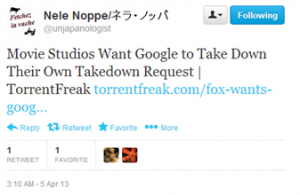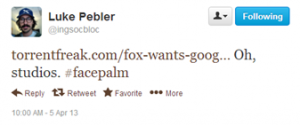On Friday, April 5, a couple of my tweeps passed along links to the TorrentFreak story Movie Studios Want Google to Take Down Their Own Takedown Request
Now, there’s a fair chance that these requests “are just another byproduct of the automated tools that are used to find infringing URLs” (TorrentFreak)—i.e., that the crawler found the URL to a copyrighted thing in the letter (which it has to be to tell Google what to take down), so it gets added to the list of takedown requests.
There’s also a possibility that the motivation has something to do with the fact that “with more than 100 million links to pirated files Google is steadily building the largest database of copyrighted material. This is rather ironic as it would only take one skilled coder to index the URLs from the DMCA notices in order to create one of the largest pirate search engines available” (TorrentFreak).
But having just read the report “Will Fair Use Survive?: Free Expression in the Age of Copyright Control” (pdf) from the Brennan Center for Justice at NYU School of Law, I see another implication, whether or not it was the intent—the system of intellectual property strongarming currently in place works best when the people being strongarmed are isolated and invisible rather than there being traces like archived takedown letters.
In the Brennan Center report, their analysis of all the letters archived by the Chilling Effects Clearinghouse for 2004 found that “more than 20% either stated weak copyright or trademark claims, or involved speech with a fair or at least reasonable free expression or fair use defense. Another 27% attacked material with possible free expression or fair use defenses” (p. ii).
Despite these weak claims or reasonable cases for legitimate use, the report found that many of the things targeted were taken down, even among a population they described as “likely to be a more knowledgeable group than the average” about their free speech and fair use rights given that they knew about Chilling Effects in the first place (p. 36).
The Brennan Center found that part of the capitulation was that the costs of fighting such takedown requests were often prohibitive—both monetary costs for lawyers and potential damages if the person who pushed back lost, and “fear, intimidation, and the emotional cost of defying an IP owner” (p. 37). And I think this speaks to the feeling of being a single individual against amassed industry legal and financial might, and I think that’s a pretty powerful force that should be taken seriously.
It was a victory for transparency (if not quite resistance to copyright maximalism) when “Google decided to forward the take-down notices to Chilling Effects while removing the listings from its index in accordance with the DMCA, and, in their place, inserting a link to the notice on the Chilling Effects site” (Brennan Center p. 29). That is, they did what they had to in accordance with the law, but they didn’t do it silently as if the alleged infringing object had never been.
TorrentFreak opines that “apparently Google has white-listed the Chillingeffects domain because it doesn’t see these indirect links as infringing,” but also notes that “Google is no stranger to removing non-direct links to links.”
This suggests that this is not a simple automated process declaring these links “indirect and noninfringing” to keep up with the 20 million takedown notices Google gets in a month (according to TorrentFreak). Instead, I think that the inclination toward transparency that led them to send things to Chilling Effects in the first place has something to do with holding the line on keeping those letters available.
These processes of shutting down speech—which the Brennan Center report found were sometimes aimed at suppressing criticism—need to happen out in the open. We should know what capital is using copyright as a blunt instrument to stifle. And they should probably have to explain in more detail why, given that such requests are spurious a nontrivial part of the time.
Right now, in Henry Jenkins’s phrase, “someone who stands to lose their home or their kid’s college fund by going head-to-head with studio attorneys is apt to fold” (Convergence Culture, p. 138) regardless of who’s in the right, and the Brennan Center report proposes that “providing for damages and attorneys’ fees where owners have made material misrepresentations in their take-down letters can help redress the imbalance” (p. 55). The Brennan Center also suggests that the legal profession “investigate the possibility of sanctions against lawyers who send frivolous cease and desist letters” (p. 57).
I think these would be excellent steps toward moving away from the use of intellectual property law as a weapon of the strong against the weak. But while we’re waiting, the traces of takedowns in the form of archived letters at Chilling Effects is the very least we can do.


